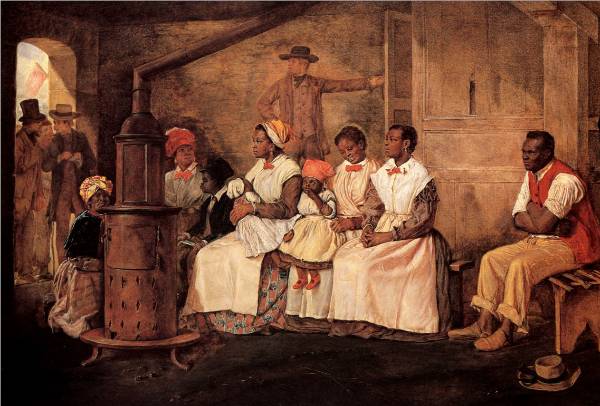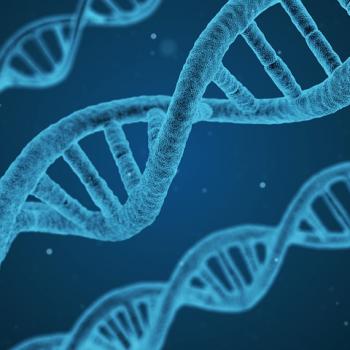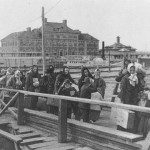
Richard Stapleton was a son of an Irish immigrant to Quebec, who then found his way to the American south, where he married a woman named Elmina, had a son, also Richard, then moved to St. Louis after his son was grown, where the younger Richard married my great-grandmother (where he promptly fathered two children, one of whom was my grandmother and the other died in infancy, before he himself died in a motorcycle crash) and the older Richard married her older (by two years) sister.
But who was Elmina?
There’a a marriage certificate for an Elmina Ussery who married a Richard Stapleton in roughly the right location, but a couple years after baby Richard’s birth.
Is this her? Why would the marriage date be after the boy’s birth, in a time and place when, well, this just wasn’t done? (And the family wasn’t poor — he was sent to a boarding school.) But what could make sense is this: Richard was an only child, and and when the older Richard remarried, they never had children even though his wife was literally young enough to be his daughter. Was he unable to father children, and was he really Richard’s stepfather? At any rate, the DNA matching algorithm for Ancestry comes up empty as to any possible Stapleton matches, and the ethnicity analysis reports that I have no Irish ancestry.
But could I gain more confidence that the Elmina in question is really Elmina Ussery in another way?
Turns out, Elmina Ussery is not a particularly common name, so it’s easy to find the family in census records: in 1880, she’s 13, the daughter of Isabel, and she works in a cotton factory, along with her widowed mother. In 1870, mom is a widowed seamstress. In 1860, as Isabel Sanders, she married Welcome Ussery, according to marriage records.
Is this enough to go on? I was able to learn more thanks to the magic of the public-to-members family trees, one of which included Welcome, Isabel, and the rest, and also went back several more generations in the past. Welcome’s father was John Ussery, and John’s father was Thomas Ussery, and John had a brother named Robert Jackson Ussery.
And this is where the Ancestry DNA matches come in: it’s possible to search for a particular surname in the family trees of members who have done DNA testing. And – bingo! I have DNA matches with several individuals who trace their ancestry to Thomas Usery.
So, yay, me, I can fill in a bit more of the family tree.
But there’s more.
Thomas Ussery was born in 1740.
Thomas Ussery is in the family tree of multiple dozens of members, and among the documents they have included in their trees is an application for a pension for Revolutionary War veterans. So that’s cool, I guess, that my ancestors are not merely homesteaders in Nebraska and downtrodden washerwomen in St. Louis, but that I would actually be eligible for DAR membership.
And then I clicked further back in the family trees. I still need to pull all of this together (one of the trees seems to skip a generation, with Thomas’s father born in 1660 and fathering Thomas at the age of 80), but another member traced the Usserys back to the late 1400s and the Sir Edward I Watson family of Rockingham Castle in England — in other words, actual English nobility.
But here’s the third discovery: Thomas Ussery left behind a will, in which he bequeaths to his children a total of 9 slaves, dividing them up among his children — and, in fact, he had bunches of children, not all of whom got a slave. Now, the details aren’t clear to me — another document shows an 840-acre farm, but only one of the slaves was slated to go to the son who inherited his property, which suggests that the slaves were used for general household duties rather than providing essential labor for the farm — unless, by the time of the will, that farm had already been divided up or he had stepped back from managing the farm in favor of his heir who himself already owned the slaves who ran the farm. And of the slaves, some are referred to as “girls,” others as “boys” and others as “men” — were these families being split up?
And, again, Thomas Ussery had bunches of children, and my presumed ancestor John was among the youngest, and inherited nothing, and his son Welcome is hardly recognizable as a descendant of English nobility — in 1850, he’s a schoolteacher whose wife (we presume she died before he married Isabel) could not read or write, and in 1860, he’s a bookkeeper living in a boardinghouse, and in 1880, his widow is so poor she must send her 13 year old daughter to the cotton factory.
So what does it mean to have a slave-owning ancestor? I’m inclined to think “nothing at all.” To the extent that the United States, as an entity, directly engaged in acts of slaveowning, then the United States as a corporate entity bears the fault, in much the same way as a corporation found to have engaged in fraud is at fault, not individual stockholders, and those same stockholders can’t say, “don’t punish the company because that would be unfair to those of us who bought stock after the fraud was perpetrated.”
And, of course, the whole issue is muddier than that, because the “United States” as an entity came into existence after slavery was already established by the colonial authorities, and the fact that the “United States” was in fact comprised of states pursuing their own interests, some never having any slaveowning economy, others emancipating their slaves voluntarily, and others having entrenched economic interests in slaveholding which resulted in the recurring conflict and crises and compromises with nonslave states, in which there was no “United States” pursuing policy as a single entity.
(Which, of course, suggests that the proper venue for any reparations claims is not the federal government, but individual state governments, some of which were very aggressive about protecting the institution of slavery.)
But of course, that’s the challenge in a country with immigration and diversity — what does it mean for a set of events in the past to be “our history” as Americans? Is it important for me, as the great-great-granddaughter of homesteaders, to reflect on the fact that they settled on land from which indigenous people were forced to leave? And, in that case, do individuals whose immigration is more recent get a “pass” — or do they bear an obligation to reflect on the misdeeds of their ancestors in their native country instead? But if that’s the case, how can we, as a country, be a people with a national identity, and with an appropriate sense of patriotism that says, “we’re all in this together and the well-being of all my fellow countrymen matters”?
And on the third hand — well, at the same time, it is cool to be able to find connections to old documents and events in history, but more as a matter of connection to those stories (which, again, are much more a matter of servants and washerwomen and farmers and lumberjacks than noble families) than any sense of achievement.
So anyway, those are my thoughts for today.










